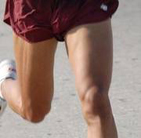Long distance running causes problems/imbalances with: Hamstrings, IT band, Quadriceps, Adductors, Gastrocnemius, Knees, Ankles, Plantar Fascia, Quadratus Lumborum, Piriformis, Gluteals, Iliopsoas, Abdominals, Trapezius, Deltoids, Teres Major, Teres Minor etc.
Distance running stresses the joints because of the repetitive pounding and jarring of the hips, knees, ankles and feet. The balance of the foot determines stress areas. Pronation or supination can occur due to imbalances of the lower leg muscles tibialis anterior and fibularis longus.
Sprinters: Iliopsoas,Tensor Fascia Latae (TFL), Gastrocnemius, Hamstrings, Piriformis, Quadratus Lumborum. Short bursts of speed require strength with higher leg lift and faster cycles of leg turnover. Running on the toes puts excess strain on the lower legs. Running only one-way on the track around the curves puts strain on the inside hip and lIliotibial bands absorb stress. The balance of the foot is important. Groin injuries and hamstring injuries can occur during starts off the blocks. Neck strain from excess speed should be treated as needed.
In runners, the most common injury-inducing technique flaw is heel striking, or landing heel first rather than on the mid-foot. Heel striking tends to cause a very sudden spike in impact forces that shoots straight up the legs, concentrating in susceptible joints such as the knees and hips. By contrast, landing on the mid-foot allows the body to better absorb more impact force in the foot, ankle and shank, so that less force reaches the knee, hip and pelvis.
While it takes time and patience, training yourself to switch from a heel-first landing stride to a mid-foot landing stride is possible. The easiest way is to practice angling your whole body slightly forward as you run, as though you're always running down a slight hill. This will force you to make ground contact with your foot more in line with your body's center of gravity, rather than out ahead of it, at a more neutral angle, instead of toes up.
Unlike sprinting, distance running does not require a significant activation of the gluteus maximus or the abdominal muscles. These muscles are lazy, relatively speaking, and try to do as little work as possible until they are needed during an intense sprint. To prove my point, simply look at the physique of any elite sprinter. You will see well-developed gluteus maximus and abdominal muscles, both of which are critical to accelerating and decelerating a sprinter's body.
The distance runner, who must conserve more energy, applies a fraction of the effort per foot strike that a sprinter does, yet during a mile will take about 750 strides per leg. Therefore, the distance runner is very dependent on the actions of the soleus muscle (long calf muscle on the back of your leg), the quadriceps group and the hip flexors. As these muscles shorten and tighten with repetitive exposure to work, they increase their passive elastic tension, resulting changes to one's posture and joint range of motion (ROM). Common structural changes in distance runners include hyper extended knees, restricted ankle dorsi flexion, tight quads, and hip flexors which restrict hip extension and pull the lumbar spine into increased curvature.
Sports Massage
As a serious sprinter/long distance runner you need a form of massage specifically designed for athletes. Adding sports massage to your workout routine can improve your performance. As the training hours and races pile up, so do the aches and pains. These little aches and pains can turn into a serious injury. Regular sports massage will help alleviate pain.
After a strenuous workout or race, sports massage will aid your recovery.
You can benefit from half an hour of work on a specific area that you feel needs attention or longer for more general and maintenance work.
Athletes around the world rely on massage as an important part of their training regimen. Sports Massage techniques, when used regularly, can increase the blood flow that is needed for recovery. Also, it will improve the range of motion and strength of injured muscles and accelerate their healing process. With a full recovery you will be able to increase your workouts and allow your body to adapt to a higher level of stress.
Call today : 086 076 4307
From NI : 00353 86 076 4307
Email : charlie@ptclinic.ie |

